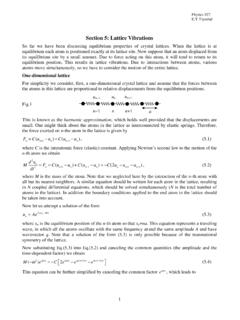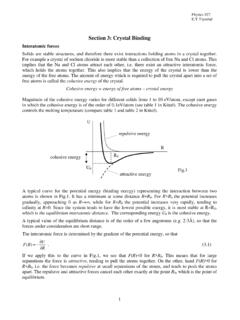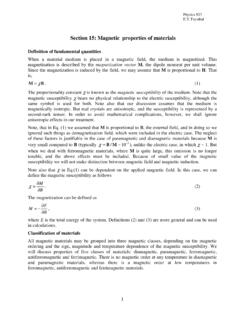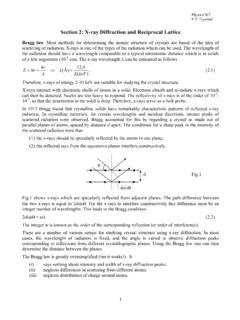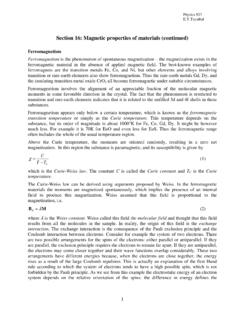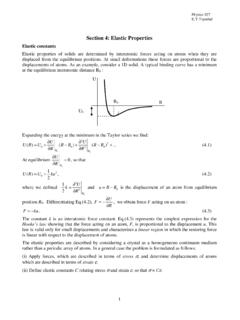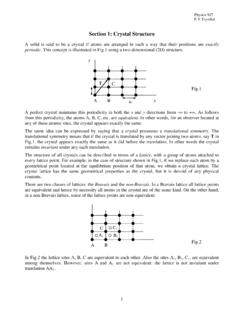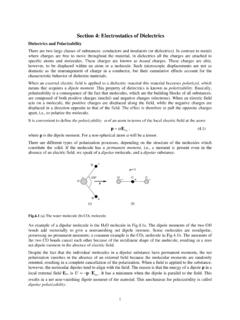Transcription of HL-93 vs HS20 - University of Nebraska–Lincoln
1 4/22/15 2015 Nebraska Bridge Conference 1 HS20-44 vs HL-93 (Standard Specifications vs LRFD Code) Fouad Jaber, Assistant State Bridge Engineer NDOR BRIDGE CONFERECE KEARNEY,NEBRASKA April 14th, 2015 Topics to cover: Topic 1: Comparison of ASD, LFD and LRFD Topic 2: LRFD Objective and calibration Topic 3: Comparison of HS20-44 VS HL-93 Topic 4: FHWA SHV s new memo Topic 5: Husbandry Vehicles and NE Legal Loads Conclusion and things to consider Topic 1 Comparison of ASD, LFD and LRFD Golden Rule of Engineering A. load > Resistance B. load = Resistance C. load < Resistance Designs must be safe, therefore? 4/22/15 2015 Nebraska Bridge Conference 2 Uncertainty Material dimensions and location Material strength Failure mode and prediction method Long term material performance Material weights Prediction of potential Live loads load analysis and distribution methods General uncertainty associated with structural function Allowable Stress Design (aka Working Stress Design) FS: Factor of Safety.
2 Ru: RESISTANCE DL + LL Ru /FS Allowable Stress Design Advantages Simplistic Limitations Inadequate account of variability Stress not a good measure of resistance Factor of Safety is subjective No risk assessment based on reliability theory load Factor Design (aka Strength Design) LFD : Coefficients load Factor : Resistance Factor DL, LL :Loads combinations Coefficients ( DL x DL+ LL x LL) Ru EX: ( x DL+ LL) + 4/22/15 2015 Nebraska Bridge Conference 3 load Factor Design Advantages load factor applied to each load combination Types of loads have different levels of uncertainty Limitations More complex than ASD No risk assessment based on reliability theory load and Resistance Factor Design (aka reliability based Design or Limit State Design) LRFD : Factor : resistance Factor DL, LL : load Factor = D R I to ( DL (DL)+ LL (LL) ) Ru EX: ( + ) + load and Resistance Factor Design Advantages Accounts for variability Uniform levels of safety Risk assessment based on reliability theory Limitations Requires availability of statistical data Resistance factors vary Old habits Topic Wrap Up 1.
3 State the difference between ASD, LFD and LRFD The three design methods are distinguished by how uncertainty is accounted for. 4/22/15 2015 Nebraska Bridge Conference 4 Topic 2 Fundamentals of LRFD Objective and calibration Objective of LRFD Develop a comprehensive and consistent load and Resistance Factor Design (LRFD) specification that is calibrated to obtain uniform reliability (a measure of safety) at the strength limit state for all materials. CALIBRATION Selection of a set of s and s to approximate a target level of reliability in an LRFD-format specification. AASHTO chose this reliability to be @ inventory level And @ operating level Calibration continued Only the strength limit states of the LRFD Specifications are calibrated based upon the theory of structural reliability , wherein statistical load and resistance data are required. The other limit states are based upon the design criteria of the Standard Specifications. Calibration for service limit state is done and implementation is underway.
4 4/22/15 2015 Nebraska Bridge Conference 5 Calibration cont. Calibration consists of up to three steps: 1. reliability - based calibration, 2. Calibration or comparison to past practice, and, 3. Liberal doses of engineering judgment. CONCLUSIONS The reliability - based LRFD design methodology is not perfect, but it represents an improvement over the ASD and LFD methodologies. LRFD utilizes structural reliability to help us select improved load and resistance factors, and it provides a framework for future improvement. 4/22/15 2015 Nebraska Bridge Conference 6 CONCLUSIONS (continued) Most of the features which designers dislike about the LRFD Specifications have little, if anything, to do with the LRFD design methodology. FHWA MEMO Topic 3 H/HS20 TRUCKS USED IN STANDARD SPECS. 4/22/15 2015 Nebraska Bridge Conference 7 HS-20 Live load TRUCK load OR LANE load Tandem and Lane load LRFD HL-93 Loading Multiple Lanes 4/22/15 2015 Nebraska Bridge Conference 8 EXEMPTION Culverts shall be design only to axle loads of a truck or Tandem (no lane loads) 1.
5 The design truck x factored force effect is equivalent to the old Standard Spec. HS-20 2. The tandem x factored force effect is equivalent to the old standard Spec. Military loads LOADS REDUCTION FATORS FACTORS WERE DEVELOPED ON THE BASIS OF AN ADTT = 5000 BRIDGE OWNERS MAY REDUCE THE LOADS BY: IF 100 <=ADTT<= ,1000,REDUCE THE LOADS BY 5% IF ADTT < 100, REDUCE THE LOADS BY 10% THE REDUCTUON IS based ON THE REDUCED PROBABILITY OF ATTAINING THE DESIGN EVENTS DURING A 75-YEAR DESIGN LIFE WITH REDUCED TRUCK VOLUME. SYSTEM PRESERVATION Standard Specifications 50 to 60-year design life v. LRFD Specifications 75-year design life 4/22/15 2015 Nebraska Bridge Conference 9 Topic 4 : FHWA Single Unit Posting Vehicle SHV or Specialized Hauling Vehicles are Legal Loads In NE Triple axle configurations of single unit vehicles (legal loads in Nebraska) have been observed to have load effects greater than HL-93 tandem axle load . 4/22/15 2015 Nebraska Bridge Conference 10 Pooled Fund Study of the Impacts of Implements of Husbandry on Bridges Topic 5 Vehicle and Bridge Data 121 Husbandry Vehicles 2 Two Axle Vehicles 37 Three Axle Vehicles 46 Four Axle Vehicles 29 Five Axle Vehicles 7 Six Axle Vehicles 174 Bridges 32 County steel girder-concrete deck 43 State steel girder-concrete deck 52 Country timber girder-timber deck 47 County steel girder-timber deck Generic Vehicles Generic three axle vehicles Generic Vehicles Cont d Generic four axle vehicle 4/22/15 2015 Nebraska Bridge Conference 11 Generic Vehicles Cont d Generic five axle vehicle Comparison of Generic Vehicles and current AASHTO specifications Included in comparison HS20 HL93 SHV Closely-spaced multi-axle single unit trucks Comparison Comparison done by Moment Ratios at critical locations John Kulicki study and development of HL93 Example Moment Ratio
6 Calculation Moment Ratio = Maximum moment value of AV3 vehicles at ---------------------------------------- ------------------------- Maximum moment value of the three axle husbandry vehicles at Ideal Moment Ratio is greater than Single Span Moment Ratios 4/22/15 2015 Nebraska Bridge Conference 12 Two Span Moment Ratios Three Span Moment Ratios Distribution of OR ratios for AV3 62 28 68 0 0 10 20 30 40 50 60 70 80 OR ratio <OR ratio<1 1 OR ratio< OR ratio Distribution of OR ratio AV3 Distribution of OR ratios for AV4 0 61 97 0 0 20 40 60 80 100 120 OR ratio <OR ratio<1 1 OR ratio< OR ratio Distribution of OR ratio AV4) 4/22/15 2015 Nebraska Bridge Conference 13 Distribution of OR ratios for AV5 0 17 138 3 0 20 40 60 80 100 120 140 160 OR ratio <OR ratio<1 1 OR ratio< OR ratio Distribution of OR ratio AV5 Wheeled grain cart, tank wagons, and fence-line feeder Single axle 20,000 pounds maximum Gross weight 20,000 pounds multiplied by the number of axles Maximum gross weight up to 80,000 pounds on Interstate and Defense highway 15% load increase during harvest season 25% increase for sugar beets will be allowed The weight of the farm tractor towing the implement is not included in the gross weight limit Taken from Nebraska DOR Truck Information Guide and Nebraska Law NEBRASKA s Legal Weight Limits Using HS20-44 Loading Difficult to be used without the Standard spec s.
7 Standard Specs was ceased to be updated by AASHTO more than 10 years ago Can t be used with New LRFD specs without additional calibration. We can t mix codes. New and young designers don t even know what LFD ,ASD and HS20-44 are. They don t teach it in college Moving forward Net load effect difference between HL-93 and HS20-44 loading is very small. reliability has improved Trucks are getting heavier and heavier We are designing for 75 years service life WHAT YOU NEED TO CONSIDER QUESTIONS???
